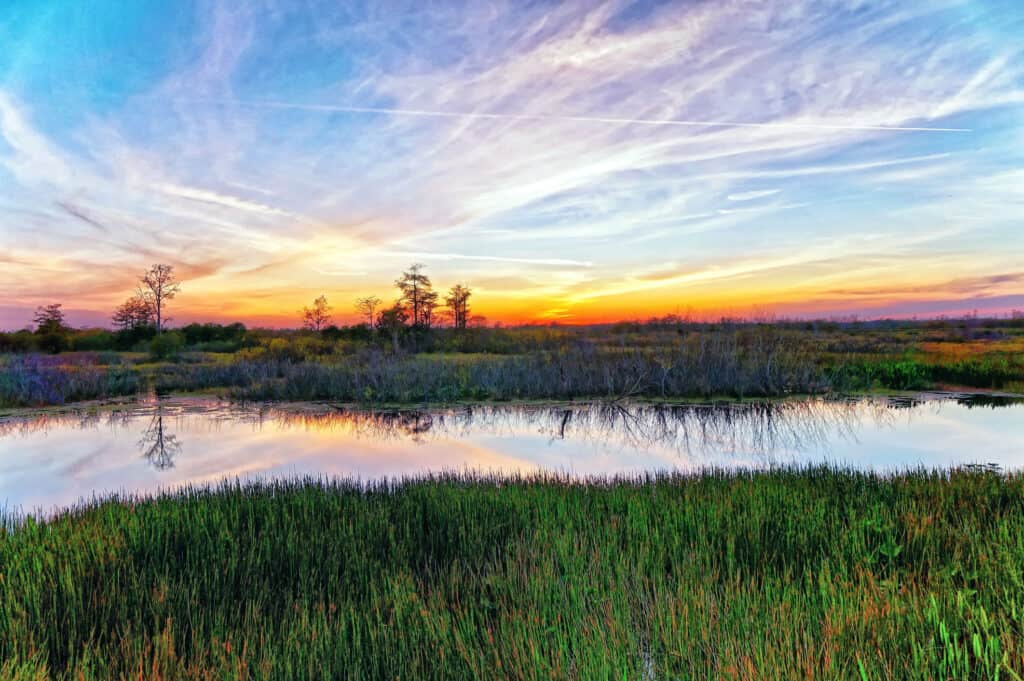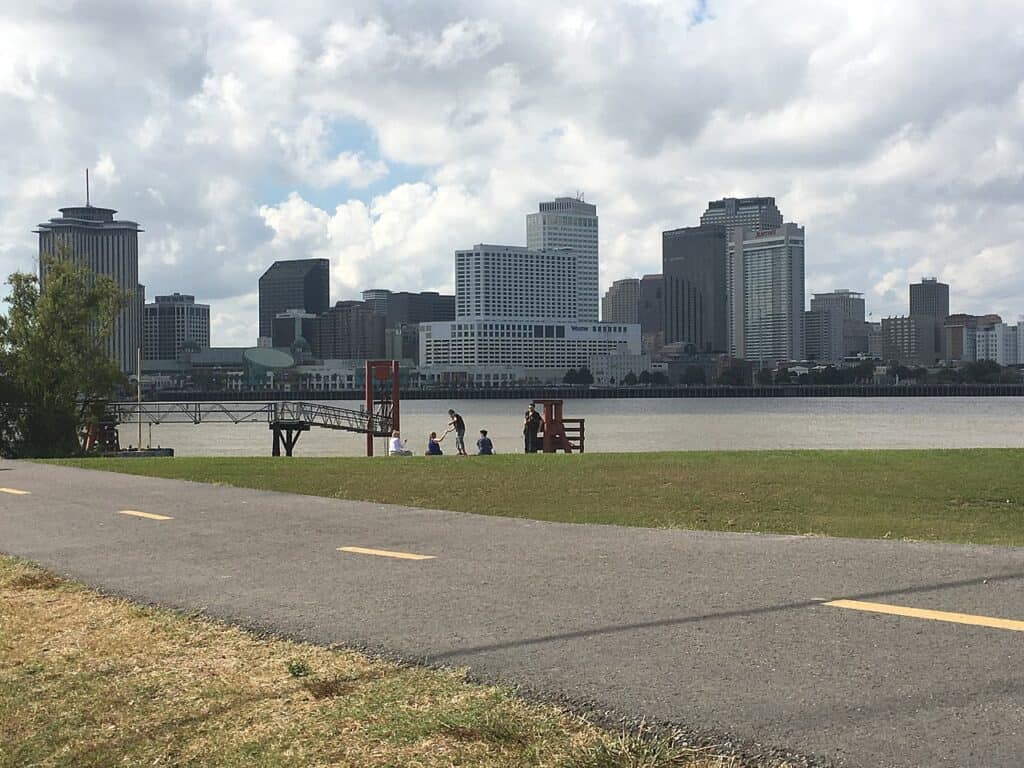Where there is water, they say, there is life. And where there is life, there is hope. From the beginning of time, people have formed settlements around water bodies, forming villages dependent on the river for drink and food. It is no surprise that the US government wants to preserve its rivers.
The Mississippi in particular is not just any river. It feeds about 20 million Americans and sustains trade and commerce within the nation. Simply put, it is one of the spines on which the US economy rests.
However, how far is too far? Is it alright to bend a river to the state’s will? What reasons are good enough to modify a river?
Recent surveys show that there is indeed a land loss crisis in Louisiana. In this article, you will find out how that problem came about, and how a few scientists may be able to reverse it.
Didn’t the US already engineer the Mississippi once?

The Mississippi River delta was formed by sediments moving down river.
©lavizzara/Shutterstock.com
Indeed. Before human intervention, the Mississippi had a mind of its own. Rivers do not wind around simply because they can, it is an intentional maneuver. Great rivers such as the Mississippi transport dirt and sediment from one area to another. And where they take sediments from becoming eroded, and where they spit these sediments out, new lands appear. This explains the formation of deltas as rivers meet seas.
The alternating patterns of rivers keep this creative process in check. When left alone, a river will not maintain one course for extended periods. It may maintain a course for a few decades, but it will shift to a new one in due time.
Unfortunately, human settlements are not so portable. And as we need water to survive, we must think of ways to keep rivers and streams running through areas that they would otherwise shift from. This was exactly the case with the United States. In the early 1800s, American scientists created clay brackets called levees, to keep the Mississippi on a single course. This designated course could now be used for trade and transport, and it became a steady dependent water body.
However, the years of captivity are telling. The sediments which ought to have formed new land have nowhere to go. This is responsible for the land loss crisis in Louisiana. The sea is creeping towards the land, and marshes are disappearing. Perhaps it is time to undo the previous engineering of the Mississippi.
What are they doing differently this time?

The US Army Corp of Engineers has created plans to get more sediment to the Lousiana coast.
©iStock.com/Jaimie Tuchman
Realizing their mistake, the US Army Corps of Engineers plans to poke a few holes in the levees that constrain the Mississippi to one channel. Doing this will allow some outflow to the marshes, carrying along with it the much-needed sediments.
These trickles that leave the Mississippi will continue to grow, spitting out soil and sediment on the Louisiana coast.
Who does the engineering benefit?
More land means more space for human settlements. Engineering the Mississippi is mostly a preventive measure; if left alone, the Louisiana coast may disappear. Louisiana has lost over 5,000 square kilometers of space already in less than a century.
So, modifying the Mississippi works for the greater good of mankind, and America in particular.
Who loses if the Mississippi is engineered?
As great as it may sound, not everyone is happy about this news. A few holes in a levee may not cause any significant changes to the flow of the Mississippi, but for people who live around the smaller channels, unleashing the Mississippi may cause problems.
Locals, fishermen, and homeowners are not excited about this plan. Just as many others have become accustomed to the great Mississippi, many families have gotten used to the salty, marshy areas they live in.
For example, a crab trader needs murky, salty water, not the strong, fresh water the Mississippi is sure to bring.
Another major concern is flooding. Having g restrained the Mississippi for so long, its release is sure to pack a punch. Certain homeowners near these newly created diversions are valid in their worry for their property.
How much will it cost?
The plan to unleash the Mississippi involves creating about 11 new diversions. These diversions alone cost $5 billion.
The entire project draws up an estimated price tag of $50 billion.
Are there risks and disadvantages associated with messing with the Mississippi?

The Mississippi River diversions will lead to increased risks of flood for about 28,000 family units.
©Dominic / CC BY-SA 4.0, via Wikimedia Commons – Original / License
The diversion of the Mississippi will lead to high-current floods in Atchafalaya. About 28,000 family units live along this route. When the Mississippi is unleashed, there will be no saying how great the damage could be. As a precaution, the government has asked these citizens and residents to relocate for a brief while. This news affects not just residents. It also affects some oil and gas companies around the area.
When did this project start?
The project has been in planning for a while now, but there is yet to be any concrete action. The project cleared a major hurdle when the Corps of Engineers released an environmental impact statement (EIS) for the project in early 2021.
It is the Army Corps of Engineers’ charge to ensure the feasibility and safety of this rerouting before convincing the local and Federal government agencies to pour in resources. To this end, they have designed virtual and physical models of the Mississippi, using tactics such as dye to study and explain how this modification may benefit the Louisiana coast line.
As of now, they hope that the project is approved before the end of the year. If that happens, work on the Mississippi will start in 2023.
Will this decision affect bottlenose dolphins and other animals?
Certain environmentalists and wildlife conservators worry that engineering the Mississippi may kill the bottlenose dolphins that live in it. Although these dolphins are common and are nowhere near extinction, it is a valid question.
We must note first of all, that rerouting the Mississippi will not close off the current route it flows in. On the contrary, the project creates more channels and routes for the river to follow.
Conclusion
In a nutshell, yes, the US government can engineer the Mississippi River, as long as they have enough reason to. This is not the first time they’ve done something like this. Years ago, they prevented the river from changing course by constructing a series of levees and dams.
Now that Louisana and certain other areas face land loss, it is time to break open some of these levees that hold the Mississippi in place. Where the Mississippi flows, new land forms.
Up Next:
Here’s When The Mississippi’s Currents Are Most Dangerous.
The 10 Best Lakes In Mississippi: Fishing, Hunting, Birdwatching & In Film
The photo featured at the top of this post is © iStock.com/Jaimie Tuchman
Sources
- Steve Hardy / Accessed August 3, 2022
- Warren Cornwall / Accessed August 3, 2022
- Eric Schmid / Accessed August 3, 2022
- Lee Southwick / Accessed August 4, 2022
- Todd C. Frankel / Accessed August 3, 2022
FAQs (Frequently Asked Questions)
How can we help the Mississippi river?
First of all, plant a tree and care for it. You may plant a local or native species or you may search for endangered species. Next, always sort your garbage. Don’t throw organic waste into the river, compost it instead.
Is the Mississippi river artificially maintained?
The Old River Control Structure (ORCS) maintains the course of the Mississippi. The US put up this artificial structure in 1963 when the river attempted to change its course.
Does the Mississippi river run through Missouri?
The Missouri river is one of the Mississippi’s largest tributaries. The Mississippi flows through or borders Tennessee, Illinois, Missouri, Iowa, Minnesota, Kentucky, Arkansas, Mississippi and Louisiana.
How strong is the Mississippi river current?
The Mississippi’s current differs at select locations. For example, the river covers 12,000 cubic feet in one second at St. Anthony falls, Minneapolis while in New Orleans it goes at a rate of 600,000 cubic feet per second
Thank you for reading! Have some feedback for us? Contact the AZ Animals editorial team.







